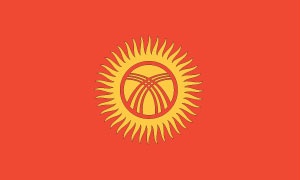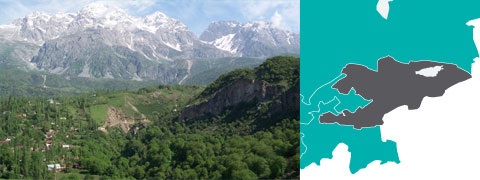Country assessments
Kyrgyz Republic
- Details
- Country assessments
2013 sector transition indicators
Source: EBRD.
Note: Water – Water and wastewater; IAOFS – Insurance and other financial services; PE – Private equity.
Highlights
- The economy rebounded strongly in 2013, after a contraction in 2012. Problems at the country’s biggest mining site in early 2012 resulted in GDP contracting by 0.9 per cent that year, but mining output has since recovered, and remittance flows have supported consumption.
- The Investment Agreement with the largest foreign investor is under review. The government and the foreign investor are discussing a new agreement underpinning the operations of Kumtor, the country’s largest mine and major source of export revenues.
- Business environment reforms continued. Progress has been made in the areas of issuing business licences and conducting inspections of businesses.
Key priorities for 2014
- Effective resolution of the Kumtor dispute is key to increasing investor confidence. Reaching an agreement on mutually acceptable terms would contribute to an improved perception of the investment climate and the rule of law, and would reduce economic uncertainty.
- Business practices and supervision in the banking system need to be strengthened. Increasing confidence in the banking system remains a key challenge. Transparent privatisation of large state-owned banks would be an important step in this direction.
- There is an urgent need to modernise the energy sector. Implementation of the medium-term strategy for the sector needs to focus on greater reliability of power supply, increased operational efficiency, and improved corporate governance and transparency in the sector.
Macroeconomic performance
Output contracted by around 0.9 per cent in 2012. The contraction was caused mainly by a combination of an industrial action and a weather-related disruption at the Kumtor gold mine in the first quarter of 2012. As the Kumtor mine accounts for up to 10 per cent of the total value-added in the economy, the disruption had a major impact on overall economic activity. The situation was compounded by the weaker performance of exports – particularly to Kazakhstan and Russia – which experienced a slow-down in the second half of 2012.
Given the one-off nature of the disruption, the economy rebounded strongly in the first half of 2013. Mining output recovered, despite a minor disruption in late May to early June, which was caused by localised protests. As a result, GDP growth reached 7.9 per cent year-on-year in the first half of 2013. Manufacturing industries and the services sectors also performed strongly, and the economy has further benefited from a sustained inflow of remittances – mainly from Russia – equivalent to up to 30 per cent of GDP.
Inflation remains highly volatile. After peaking at over 20 per cent year-on-year in early 2011, inflation decelerated to 2 per cent at the end of August 2012. It subsequently picked up, reaching 8 per cent year-on-year at the end of March 2013, owing primarily to higher food prices. The exchange rate has remained broadly stable, depreciating by around 2 per cent against the US dollar during 2012.
The external and fiscal positions worsened. As a result of weaker growth performance the current account balance widened sharply, to around 15.3 per cent of GDP in 2012, and the fiscal deficit reached 5.4 per cent of GDP. The twin deficits are expected to narrow in 2013 as the economy recovers. The International Monetary Fund’s Extended Credit Facility programme has remained broadly on track, and the fourth review under the programme was successfully completed in June 2013. The financial system is still overcoming the aftermath of the 2010 crisis. Following the restructuring of the Kyrgyz Republic’s Asia Universal Bank, the official non-performing loans ratio has remained relatively low. At the same time, the true quality of assets in the banking system is somewhat uncertain because of state-supported lending programmes involving two commercial banks.
GDP growth is expected to rebound in 2013. However, risks to the economic outlook have increased, given the deceleration of the Russian economy – the key source of remittances to the Kyrgyz Republic – and the uncertain outcome of the dispute surrounding Kumtor.
Major structural reform developments
In early 2013 negotiations began between the government and the Canadian mining firm, Centerra, on a new tax regime for Kumtor. Discussions centre on proposed revisions to the 2009 version of the Investment Agreement, which grandfathered Kumtor against future changes in the tax regime. A State Commission has also recommended imposing higher environmental charges and demanding up to US$ 315 million in environmental damages (equivalent to around 5 per cent of the country’s GDP). As of mid-2013, discussions were ongoing; the parliament has instructed the government to unilaterally invalidate the 2009 Investment Agreement in case the parties cannot agree on mutually acceptable terms. Meanwhile, operations at Kumtor were subject to a brief disruption in late May-early June 2013, as a result of popular protests, but production has since resumed.
Business environment reforms continued. Legislation passed in October 2012 streamlines procedures for issuing business licences and conducting inspections of businesses. In December 2012 the roles and responsibilities of business inspectors were further clarified. The Kyrgyz Republic scored relatively well in the World Bank 2014 Doing Business report, ranking sixty-eighth of 189 countries in terms of ease of doing business. At the same time, the business environment remains difficult in a number of areas, including getting electricity and trading across borders.
A local microfinance institution (MFI) received permission from the National Bank of the Kyrgyz Republic to operate as a bank. Bai Tushum and Partners thus became the first MFI in Central Asia to convert to a fully licensed bank. This development has the potential to further strengthen the banking sector and improve access to banking services in the country. The state’s 90 per cent shareholding in Zalkar Bank – a state-owned bank that took over the “good” assets of the Asia Universal Bank, which failed in the 2010 banking crisis – was sold to a Russian business group, ITB Holding, for US$ 4 million in April 2013. The price is within the range of valuations suggested by the International Finance Corporation. The winning bid was the only bid at the auction, while a number of earlier auctions had failed to attract any interest.
KyrgyzGas was sold to Gazprom. As the financial situation of KyrgyzGas – the national gas transportation and distribution company – deteriorated, gas supplies from Kazakhstan were interrupted at the height of winter due to payment arrears. Against this background, in January 2013 the Kyrgyz government agreed to sell KyrgyzGas to Russia’s Gazprom, for a nominal price, while Gazprom committed to paying off KyrgyzGas’s debts and investing in modernisation of the company’s ageing assets. An intergovernmental agreement regarding the sale was signed in July 2013.
In May 2013 the Kyrgyz Republic was officially confirmed as a candidate country to accede to the Eurasian Economic Union, to join Belarus, Kazakhstan and Russia. The Eurasian Economic Commission – the supranational body of the Union – and the Kyrgyz authorities are currently working on an accession road map. The accession process may take several years to complete.













